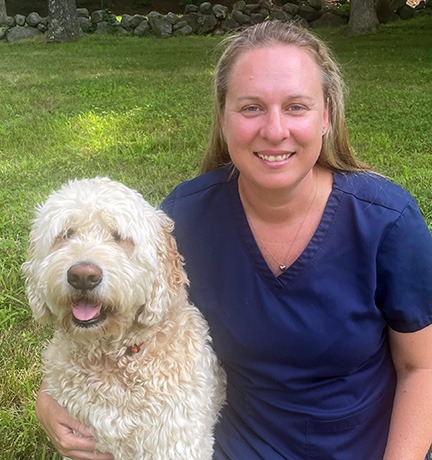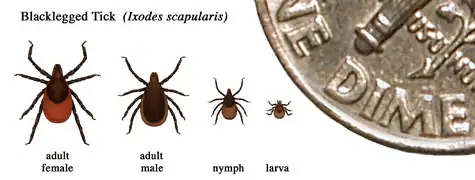-
Adopt
-
Veterinary Care
Services
Client Information
- What to Expect – Angell Boston
- Client Rights and Responsibilities
- Payments / Financial Assistance
- Pharmacy
- Client Policies
- Our Doctors
- Grief Support / Counseling
- Directions and Parking
- Helpful “How-to” Pet Care
Online Payments
Emergency: Boston
Emergency: Waltham
Poison Control Hotline
-
Programs & Resources
- Careers
-
Donate Now
 By Julie Shields, DVM
By Julie Shields, DVM![]()
angell.org/westprimarycare
angellwestgeneralmedicine@angell.org
781-902-8400
April 2024
X
X
Introduction
’Tis the springtime season, when the stress of tick diseases comes to mind. Lyme disease is one of the most common tick diseases in the Northeast. Lyme, caused by a bacteria called Borrelia burgdorferi, can be transmitted to your furry family members through a bite of an infected tick. The most common tick that carries Lyme disease is the deer tick, also known as the black-legged tick. When a tick bites, the bacteria enters the dog’s body while the tick is feeding and then migrates through the tissue and localizes in the joints, causing acute arthritis (joint pain). If the dog is left untreated, it can cause damage to the kidneys, nervous system, and heart.
People can get Lyme disease, too, but dogs cannot directly give you the disease. However, the same tick that bites them can bite you and transmit the disease. Therefore, preventing exposure to ticks is vital for you and your dog.
Clinical Signs
Unfortunately, several clinical signs are associated with Lyme disease, which may not show until two to five months after a tick bite. The most common clinical signs of Lyme disease are lameness, swollen joints, swollen lymph nodes, lethargy, and, at times, decreased appetite.
Even though the characteristic “bull’s-eye” rash at the bite site is a common clinical sign for people, dogs do not develop this.
How Is It Diagnosed?
Lyme disease can be frustrating and difficult to diagnose since many dogs will test positive on routine blood tests, whether or not they are sick from Lyme disease. There is a standard screening test for Lyme disease called the Snap 4dx or Accuplex (depending on the lab used). This test not only tests for Lyme disease but also for heartworm disease and two other tick-borne diseases, Analplasma and Ehrlichia. These tests can detect antibodies to the bacteria (Borrelia) as early as three to five weeks after a dog has been bitten by an infected tick (even before clinical signs develop).
If positive, it is recommended that another test be run for confirmation. A Lyme Quant C6 antibody test is recommended to evaluate for active infection and to establish a baseline to assess response to treatment if indicated. It is also ideal to perform a urinalysis/urine protein creatinine ratio to evaluate for proteinuria (protein in the urine) and to help determine if Lyme disease has affected the kidneys.
If the Lyme Quant C6 antibody level is greater than 30 with clinical disease, it is recommended that the patient be treated and the C6 level be rechecked in six months.
If the protein level in the urine is greater than 0.2, it is recommended to investigate glomerulonephritis (kidney involvement).
Please ask your veterinarian if you have any questions since not every case is the same.
Treatment
Lyme disease is treated with antibiotics, most commonly doxycycline, for four weeks. Pain medications should also be given to help with joint pain. Asymptomatic patients may only require monitoring with blood tests and routine urine checks.
How to Prevent Lyme Disease
- Since Lyme disease takes at least 24 to 48 hours to transmit, tick checks and prompt removal are crucial to avoid infection. These ticks can be small and difficult to see, and reliable year-round tick preventatives are strongly recommended. (There are a variety of products, from collar topicals to chewables).
- Routine tick checks, especially after going in tall grasses or wooded areas.
- Vaccinations

This is a representation of how small the ticks can appear.
Lyme Vaccine
A safe and effective vaccine is available to protect dogs against Lyme disease. This vaccine is initially given in two doses, three weeks apart, and then yearly. The Lyme vaccine does not replace the need for year-round tick prevention. The decision to vaccinate can be discussed with your veterinarian based on your dog’s lifestyle and individual risk assessment.
Glomerular Disease (Kidney Disease)
It is essential to know that there is a severe complication of Lyme disease called glomerular nephritis. While this only occurs in a small number of patients, the insult to the kidneys can be detrimental. The good news is that a large percentage of patients will not develop this condition. Regular urine screening tests are the best way to get ahead of this severe complication.
Prognosis
If your dog is treated swiftly and successfully, the prognosis for Lyme disease is good. It is recommended that kidney values be monitored yearly when your dog has had a Lyme positive.
Summary
- Lyme disease is becoming more prevalent all around the country.
- Lyme disease is preventable by regular tick checks, avoiding high-tick regions, using year-round preventatives, and vaccinating in high-risk areas.
- Transmission does not occur 24 to 48 hours after initial attachment by an infected tick.
- Diagnosing Lyme disease is based on a combination of clinical signs, blood work, and urine testing.
- Treatment is an antibiotic, doxycycline, for four weeks.
